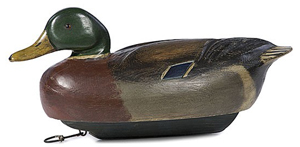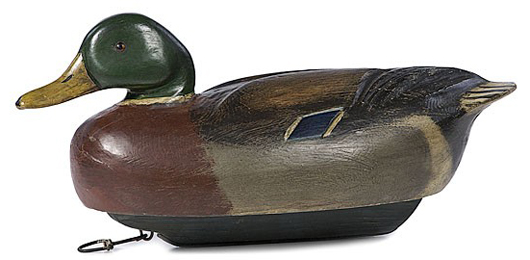
NORTHGLENN, Colo. (AP) – Considering his collection of more than 130 antique and contemporary decoys, some worth more than $1,000 and some he calls “virtually worthless,” Bill Walters shrugged.
“Why would you want to collect these?” he asked, rhetorically.
“I don’t know. Because of the feeling I get when I look at them.”
Take, for example, the two Mallard drakes that hunter Ben Schmidt carved sometime in the 1940s. Run a hand over their sleek backs, and feel the individual feathers, short and long, chiseled from the wood.
Or look at the bald-pate duck carved by Jim Schmiedlin, another hunter and celebrated folk artist. Touch a finger to its back, and it’s a surprise that you can’t feel the feathers so painstaking detailed that they look sculpted, not painted.
Turn the decoy over, and you’ll find all the lakes where Schmiedlin used this piece on duck-hunting trips.
“These decoys were made to use,” Walters said approvingly. He carves decoys, too, and uses them in his seasonal duck-hunting trips.
Trim, with a military bearing, Walters bears a strong resemblance to the actor Martin Sheen. After retiring from his career with the Internal Revenue Service – “I used to press freshly laundered money,” he tells people who ask for details about his former job – Walters devoted more time to his avocation of collecting and carving duck decoys.
Along with other members of the Midwest Decoy Collectors Association, Walters displayed decoys from his collection at the Bass Pro Shop fall hunting exposition in August.
“Bill and his friends are so proud and really passionate about this American art form,” said Simone Geoffrion, promotions director for Bass Pro Denver.
“When I first saw his decoys, I got caught up in that passion. They have decoys from the 1800s to the present. I don’t know if they bring their most treasured pieces, but they never leave that decoy (by itself), either. And then when people come in, bringing their decoys to be appraised, you never know what to expect.”
She remembered a man who arrived at the Bass Pro fall hunting classic one year, carrying a large decoy in a battered pillowcase. Even before the man removed the case, the other decoy collectors converged around him like ducks competing for hunks of bread.
“I thought, wow, this guy has something special, and when he left, I asked Bill why he was so excited,” Geoffrion said.
“Bill said, ‘That was very rare, made by a famous artist. That particular goose decoy has a crack in it.’ You know how wood separates sometimes?
“Bill said, ‘The crack dropped its value, but it’s still worth at least $25,000.’ I asked what it would’ve been worth if it wasn’t cracked, and he said ‘About $55,000.’ And it was just wrapped up in an old pillowcase!”
Walters lives for moments like that. Once, a woman asked him to appraise 14 decoy ducks. One was an eider decoy that Walters recognized as the work of a Maine carver.
The woman looked surprised. That one? Her children liked to play with it.
Walters, whose collectible ducks are carefully mounted on professional racks, tried not to wince. He suggested sending the decoy to an auction house for a targeted appraisal.
“It came back with a preauction estimate of $17,000 to $19,000,” Walters said.
“Needless to say, she took them up on it. It sold for $19,200. And she’s still got all these other birds! She had everything from worthless to four good pieces that we looked up. Not great finds, like the eider decoy, but all around $1,000 or so. Now she’s going to have to decide whether to keep them or put them up for auction.”
As for his own collection, Walters doesn’t intend to auction any of them in the near future. He sidesteps direct questions about the value of his rarest decoys.
“I have three or four that are priceless because I love ’em,” he said. “Sure, some of them are worth a thousand or so. Another one might be maybe 50 bucks, because it’s an unknown carver.
“But eliminate the price. Why would you want to collect this? I don’t know. Because it’s art. Because of the feeling you get when you look at it, and think, ‘Boy, I really like that.’”
___
Information from: The Denver Post, http://www.denverpost.com
Copyright 2012 Associated Press. All rights reserved. This material may not be published, broadcast, rewritten, or redistributed.
AP-WF-08-30-12 1847GMT
ADDITIONAL IMAGE OF NOTE


